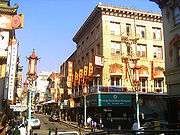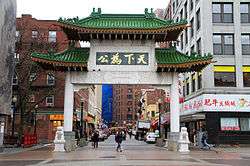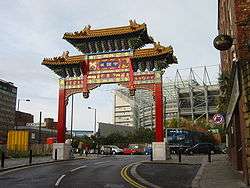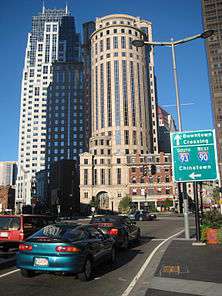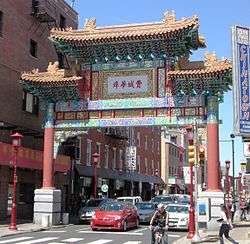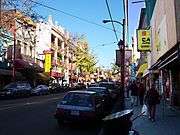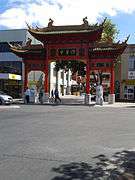Chinatown
| Chinatown | |||||||||||||||||||||||||
|
| |||||||||||||||||||||||||
| Chinese | 唐人街 | ||||||||||||||||||||||||
|---|---|---|---|---|---|---|---|---|---|---|---|---|---|---|---|---|---|---|---|---|---|---|---|---|---|
| Literal meaning | "Chinese Street" | ||||||||||||||||||||||||
| |||||||||||||||||||||||||
| Alternative Chinese name | |||||||||||||||||||||||||
| Traditional Chinese | 中國城 | ||||||||||||||||||||||||
| Simplified Chinese | 中国城 | ||||||||||||||||||||||||
| Literal meaning | "Chinatown" | ||||||||||||||||||||||||
| |||||||||||||||||||||||||
| Second alternative Chinese name | |||||||||||||||||||||||||
| Traditional Chinese | 華埠 | ||||||||||||||||||||||||
| Simplified Chinese | 华埠 | ||||||||||||||||||||||||
| Literal meaning | "Chinese District" | ||||||||||||||||||||||||
| |||||||||||||||||||||||||
| Chinatowns |
|---|
A Chinatown (Chinese: 唐人街; pinyin: Tángrénjiē; Jyutping: tong4 yan4 gaai1) is an ethnic enclave of Chinese or Han people located outside mainland China, Hong Kong, Macau, or Taiwan, most often in an urban setting. Areas known as "Chinatown" exist throughout the world, including Asia, Australia, the Americas, Africa and Europe.
The development of most Chinatowns typically resulted from mass migration to an area without any, or with very few Chinese residents. Binondo in Manila, established in 1594, is recognised as the world's oldest Chinatown. Notable early examples outside Asia include San Francisco's Chinatown in the United States and Melbourne's Chinatown in Australia, which were founded in the mid-19th century during the California gold rush and Victoria gold rush respectively. A more modern example, in Montville, Connecticut, was caused by the displacement of Chinese workers in the Manhattan Chinatown following the September 11th attacks in 2001.[1][2]
Definition
The Oxford Dictionary defines "Chinatown" as "... a district of any non-Chinese town, especially a city or seaport, in which the population is predominantly of Chinese origin".[3] However, some Chinatowns may have little to do with China.[4] Some "Vietnamese" enclaves are in fact a city's "second Chinatown", and some Chinatowns are in fact pan-Asian, meaning they could also be counted as a Koreatown or Little India.[5] One example includes Asiatown in Cleveland, Ohio. It was initially referred to as a Chinatown but was subsequently renamed due to the influx of non-Chinese Asian Americans who opened businesses there. Today the district acts as a unifying factor for the Chinese, Taiwanese, Korean, Japanese, Filipino, Indian, Vietnamese, Cambodian, Laotian, Nepalese and Thai communities of Cleveland.[6]
Further ambiguities with the term can include Chinese ethnoburbs which by definition are "...suburban ethnic clusters of residential areas and business districts in large metropolitan areas [7] where the intended purpose is to be " ... as isolated from the white population as Hispanics".[8] An article in The New York Times blurs the line further by categorizing very different Chinatowns such as Chinatown, Manhattan, which exists in an urban setting as "traditional"; Monterey Park's Chinatown, which exists in a "suburban" setting (and labeled as such); and Austin, Texas's Chinatown, which is in essence a "Chinese themed mall", known as "fabricated". This contrasts with narrower definitions, where the term only described Chinatown in a city setting.[9]
In some cities in Spain, the term denotes an area, neighborhood or district where prostitution or other businesses related to the sex industry are concentrated; i.e. a red-light district. Some examples of this are the Chinatown of Salamanca and the Chinatown of Barcelona, although in Barcelona there was a small Chinese community in the 1930s.
History
Trading centres populated predominantly by Chinese men and their native spouses have long existed throughout Southeast Asia. Emigration to other parts of the world from China accelerated in the 1860s with the signing of the Treaty of Peking (1860), which opened the border for free movement. Early emigrants came primarily from the coastal provinces of Guangdong (Canton, Kwangtung) and Fujian (Fukien, Hokkien) in southeastern China – where the people generally speak Toishanese, Cantonese, Hakka, Teochew (Chiuchow) and Hokkien. In the late 19th century and early 20th century, a significant amount of Chinese emigration to North America originated from four counties called Sze Yup, located west of the Pearl River Delta in Guangdong province, making Toishanese a dominant variety of the Chinese language spoken in Chinatowns in Canada and the United States.
As conditions in China have improved in recent decades, many Chinatowns have lost their initial mission, which was to provide a transitional place into a new culture. As net migration has slowed into them, the smaller Chinatowns have slowly decayed, often to the point of becoming purely historical and no longer serving as ethnic enclaves.[10]
In Asia

Binondo's Chinatown located in Manila, Philippines is the oldest Chinatown in the world, established in 1594.[11]
Several Asian Chinatowns, although not yet called by that name, have a long history. Those in Nagasaki, Japan,[12] Binondo in Manila, Hoi An and Bao Vinh in central Vietnam[13] all existed in 1600. Glodok, the Chinese quarter of Jakarta, Indonesia, dates to 1740.[14]
Chinese presence in India dates back to the 5th century AD.[15] A Chinatown first appeared in the Indian city of Calcutta (now renamed Kolkata) and subsequently in Mumbai and Chennai. The first Chinese settler in Calcutta was Young Atchew around 1780.
The Chinatown centered on Yaowarat Road in Bangkok, Thailand, was founded at the same time as the city itself, in 1782.[16]
In the West
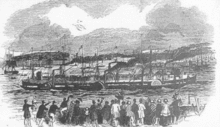
An early enclave of Chinese people emerged in the 1830s in Liverpool, England when the first direct trading vessel from China arrived in Liverpool's docks to trade in goods including silk and cotton wool.[17] Many Chinese immigrants arrived in Liverpool in the late 1850s in the employ of the Blue Funnel Shipping Line, a cargo transport company established by Alfred Holt. The commercial shipping line created strong trade links between the cities of Shanghai, Hong Kong and Liverpool, mainly in the importation of silk, cotton and tea.[17]
The Chinatown in San Francisco is one of the largest in North America and the oldest north of Mexico. It served as a port of entry for early Chinese immigrants from the 1850s to the 1900s.[18] The area was the one geographical region deeded by the city government and private property owners which allowed Chinese persons to inherit and inhabit dwellings within the city. Many Chinese found jobs working for large companies seeking a source of labor, most famously as part of the Central Pacific[19] on the Transcontinental Railroad. Other early immigrants worked as mine workers or independent prospectors hoping to strike it rich during the 1849 Gold Rush. Other cities in North America where Chinatowns were founded in the mid-nineteenth century include almost every major settlement along the West Coast from San Diego to Victoria.
Economic opportunity drove the building of further Chinatowns in the United States. The initial Chinatowns were built in the Western United States in states such as California, Oregon, Washington, Idaho, Utah, Colorado, and Arizona. As the transcontinental railroad was built, more Chinatowns started to appear in railroad towns such as St. Louis, Chicago, Cincinnati, Pittsburgh, Butte Montana, and many east coast cities such as New York City, Boston, Philadelphia, Providence, and Baltimore. With the passage of the Emancipation Proclamation, many southern states such as Arkansas, Louisiana, and Georgia began to hire Chinese for work in place of slave labor.[20]
The history of Chinatowns was not always peaceful, especially when labor disputes arose. Racial tensions flared when lower-paid Chinese workers replaced white miners in many mountain-area Chinatowns, such as in Wyoming with the Rock Springs Massacre. Many of these frontier Chinatowns became extinct as American racism surged and the Chinese Exclusion Act was passed.
Other Chinatowns in European capitals, including Paris and London, were established at the turn of the 20th century. The first Chinatown in London was located in the Limehouse area of the East End of London[21] at the start of the 20th century. The Chinese population engaged in business which catered to the Chinese sailors who frequented the Docklands. The area acquired a bad reputation from exaggerated reports of opium dens and slum housing.
France received a large settlement of Chinese immigrant laborers, mostly from the city of Wenzhou, in the Zhejiang province of China. Significant Chinatowns sprung up in Belleville and the 13th arrondissement of Paris.
1970s to the present
By the late 1970s, refugees and exiles from the Vietnam War played a significant part in the redevelopment of Chinatowns in developed Western countries. As a result, many existing Chinatowns have become pan-Asian business districts and residential neighborhoods. By contrast, most Chinatowns in the past had been largely inhabited by Chinese from southeastern China.
In 2001, the events of September 11 have resulted in a mass migration of about 14,000 Chinese workers from Manhattan's Chinatown to Montville, Connecticut due to the fall of the garment industry and workers transitioning to casino jobs fueled by the development of the Mohegan Sun casino.
In 2012, Tijuana's Chinatown formed as a result of availability of direct flights to China. The La Mesa District of Tijuana was formerly a small enclave, but has tripled in size as a result of direct flights to Shanghai, with an ethnic Chinese population rise from 5,000 in 2009 to roughly 15,000 in 2012, overtaking Mexicali's Chinatown as the largest Chinese enclave in Mexico.
Chinese-themed shopping centers
In recent years, Chinese-themed shopping centers have started to take on a role as historical and touristic centers, though the centers themselves are not "Chinatowns" by definition, usually as they are built in areas where the Chinese populations are intermixed with the general population at large. For example, the "Chinatown" in Albany, New York has been created as an attraction rather than an enclave, intended to give the feeling of the "old Chinatown" in an upscale setting.[22] The new Chinatown in Raleigh, North Carolina will be built with a five-star hotel, and is intended mainly as a visitor attraction.[23] Other examples of Chinese-themed malls exist in Richmond, British Columbia, Houston, Las Vegas, Dubai, and Santo Domingo have received official recognition as a "Chinatown". While many Chinese-themed areas have in many cases displaced original Chinese enclaves as places where authentic Chinese cuisine restaurants and shopping can be found, they are not considered tourist attractions as the most notable historic Chinatown districts are.[24] Bonnie Tsui in her book states that the newer "commercial Chinatowns" rely on the Chinatown being built before the local Chinese population arrives.[25]
Characteristics
The features described below are characteristic of many modern Chinatowns.
Demographics
The early Chinatowns such as those in San Francisco and Los Angeles in the United States were naturally destinations for people of Chinese descent as migration were the result of opportunities such as the California Gold Rush and the Transcontinental Railroad drawing the population in, creating natural Chinese enclaves that were almost always 100% exclusively Han Chinese, which included both people born in China and in the enclave, in this case American born Chinese.[26] In some free countries such as the United States and Canada, housing laws that prevent discrimination also allows neighborhoods that may have been characterized as "All Chinese" to also allow non-Chinese to reside in these communities. For example, the Chinatown in Philadelphia show sizeable white and black races residing within the community.[27] A recent study also suggests that the demographic change is also driven by gentrification of what were previously Chinatown neighborhoods. The influx of luxury housing is speeding up the gentrification of such neighborhoods. The trend for emergence of these types of natural enclaves is on the decline (with the exceptions being the continued growth and emergence of newer Chinatowns in Queens and Brooklyn in New York City), only to be replaced by newer "Disneyland-like" attractions, such as a new Chinatown that will be built in the Catskills region of New York.[28] This includes the endangerment of existing historical Chinatowns that will eventually stop serving the needs of Chinese immigrants. Newer developments like those in Norwich, Connecticut and the San Gabriel Valley, which are not necessarily considered "Chinatowns" in the sense that they do not necessarily contain the Chinese architectures or Chinese language signs as signatures of an officially sanctioned area that was designated either in law or signage stating so, differentiate areas that are called "Chinatowns" versus locations that have "significant" populations of people of Chinese descent. For example, San Jose, California in the United States has 63,434 people (2010 U.S. Census) of Chinese descent, and yet "does not have a Chinatown." Some "official" Chinatowns have Chinese populations much lower than that.[29]
Architectural styles
Many tourist-destination metropolitan Chinatowns can be distinguished by large red arch entrance structures known in Mandarin Chinese as Paifang (sometimes accompanied by imperial guardian lion statues on either side of the structure, to greet visitors). Other Chinese architectural styles such as the Chinese Garden of Friendship in Sydney Chinatown and the Chinese stone lions at the gate to the Victoria, British Columbia Chinatown are present in some Chinatowns. Mahale Chiniha, the Chinatown in Iran, contains many buildings that were constructed in the Chinese architectural style.
Paifangs usually have special inscriptions in Chinese. Historically, these gateways were donated to a particular city as a gift from the Republic of China and People's Republic of China, or local governments (such as Chinatown, San Francisco), and business organizations. The long-neglected Chinatown in Havana, Cuba, received materials for its paifang from the People's Republic of China as part of the Chinatown's gradual renaissance. Construction of these red arches is often financed by local financial contributions from the Chinatown community. Some of these structures span an entire intersection, and some are smaller in height and width. Some paifang can be made of wood, masonry, or steel and may incorporate an elaborate or simple design.

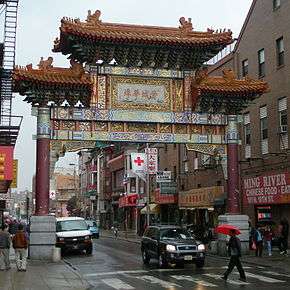

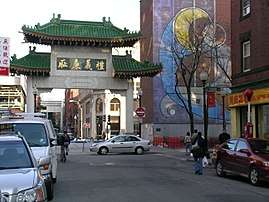

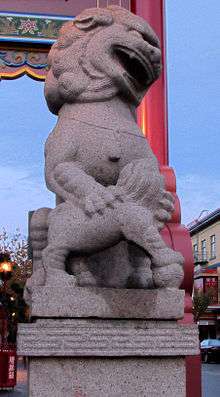
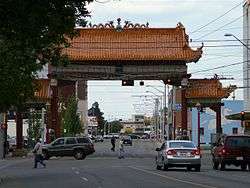
Chinese language signs
Chinese characters are very commonly seen in areas officially labeled as "Chinatown", and many stores that are located in such districts use Chinese calligraphy on storefront signs. Many Chinatowns, such as the one in Oakland, California, employ bilingual street signs that are in Chinese as well as English.
In Washington, DC's Chinatown, storefront signs are required to have a translation in Chinese characters when the establishment is located in this district, whether the store is Chinese in nature or not. Local franchises of national chains, such as Starbucks coffeeshops and CVS drugstores conform to this rule.[30]
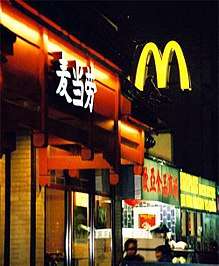
.jpg)
Chinese restaurants
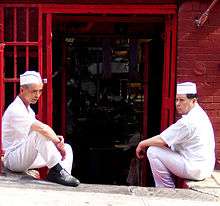
Most Chinatowns are centered on food, and as a result Chinatowns worldwide are usually popular destinations for various ethnic Chinese and other Asian cuisines such as Vietnamese, Thai, and Malaysian. Some Chinatowns, such as in Singapore, have developed their own localized style of Chinese cuisine. Chinatown restaurants serve both as major economic components and as social gathering places. In the Chinatowns in many western countries, restaurant work may be the only type of employment available for poorer immigrants, especially those who cannot converse fluently in the language of the adopted country. Most Chinatowns generally have a range of authentic and tourist-oriented restaurants.
Some restaurants in Chinatown do not cater towards non-Chinese customers. Because of ethnic Chinese immigration and the expanded palate of many contemporary cultures, the remaining American Chinese and Canadian Chinese cuisine restaurants are seen as anachronisms, but remain popular and profitable. In many Chinatowns, there are now many large, authentic Cantonese seafood restaurants, restaurants specializing in other varieties of Chinese cuisine such as Hakka cuisine, Szechuan cuisine, Shanghai cuisine, and small restaurants with delicatessen foods.
Cantonese seafood restaurants
Cantonese seafood restaurants (海鮮酒家, Pinyin: Hǎixiān Jiǔjiā, pronounced in Cantonese as hoy seen jau ga) typically use a large dining room layout, have ornate designs, and specialize in seafood such as expensive Chinese-style lobsters, crabs, prawns, clams, and oysters, all kept live in fish tanks until preparation. Some seafood restaurants may also offer dim sum in the morning through the early afternoon hours, as waiters announce the names of dishes while pushing steaming carts of food and pastries around the restaurant. These restaurants are also a popular place for weddings, banquets, and other special events.
These types of restaurants flourished and became in vogue in Hong Kong during the 1960s, and subsequently began opening in various Chinatowns overseas. Owing to their higher menu prices and greater amount of investment capital required to open and manage one (due to higher levels of staffing needed), they tend to be more common in Chinatowns and satellite communities in developed countries and in fairly affluent Chinese immigrant communities, notably in Australia, Canada, and the United States, where they have received significant population of Hong Kong Chinese émigrés. Poorer immigrants usually cannot start these kinds of restaurants, although they too are employed in them. There are generally fewer of them in the older Chinatowns; for example, they are practically non-existent in Vancouver's Chinatown, but are found in its suburbs such as Richmond, British Columbia, Canada. Competition between these restaurants is often fierce; hence owners of seafood restaurants hire and even "steal" the best chefs, many of whom are from Hong Kong.
Barbecue delicatessens/restaurants
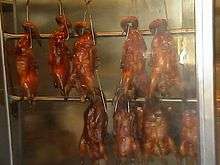
Also, Chinese barbecue deli restaurants, called siu laap (燒臘 shāo là) and sometimes called a "noodle house" or mein ga (麵家 miàn jiā), are generally more modest in size and decor, and serve less expensive fare such as wonton noodles (or wonton mein), chow fun (炒粉 chǎo fěn, stir-fry rice noodles), Yeung Chow fried rice (揚州炒飯 Yángzhōu chǎofàn), and rice porridge or congee, known as juk in Cantonese Chinese. They also tend to have displays of whole pre-cooked roasted ducks and suckling pigs hanging in their windows, a common feature in most Chinatowns worldwide. These delis also serve barbecue pork (叉燒 chāshāo, cha siu), tripe, chicken feet, and other Chinese-style items less familiar to the typical Western palate. Food is usually intended for take-out. Some of these Chinatown restaurants sometimes have reputations for being "greasy spoons" and for poor service, whereas others may be clean and well-lit, with suitable decor and attentive waitstaff.
Vietnamese immigrants, both ethnic Chinese and non-Chinese, have opened restaurants in many Chinatowns, serving Vietnamese pho beef noodle soups and Franco-Vietnamese sandwiches. Some immigrants have also started restaurants serving Teochew Chinese cuisine. Some Chinatowns both old and new may also contain several pan-Asian restaurants offering a variety of Asian noodles under one roof.
Localized cuisines
Chop suey and chow mein eateries (United States)
Often lit by neon signage, restaurants offering chop suey or chow mein, mainly for the benefit of non-Chinese customers, were frequent in older Chinatowns. These dishes also are offered in standard barbecue restaurants and takeouts (take-away restaurants).
Chifas (Peru)
A special feature of the Chinatown in Lima, Peru (Barrio Chino de Lima) is the chifa, a Chinese-Peruvian type of restaurant which mixes Cantonese Chinese cuisine with local Peruvian flavors. Chifa is the Peruvian Spanish derivative of the Cantonese phrase jee fon (饎飯 chì fàn), which renders as "cook rice" or as "cook meal'". This type of restaurant is popular with native Peruvians.
Chinese and Asian businesses
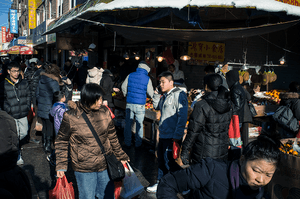
Most Chinatown businesses are engaged in the import-export and wholesale businesses; hence a large number of trading companies are found in Chinatowns.
Markets and supermarkets
In addition to the restaurant trade, grocery stores and seafood markets serve a key function in Chinatown economies, and these stores sell Chinese ingredients to such restaurants as well as to the general public. Some markets are wholesalers, while smaller Chinatown grocers and markets are often characterized by sidewalk vegetable and fruit stalls, a quintessential image of many Chinatowns. Many local residents buy fresh food daily, taking advantage of its ready availability, and also avoiding the space, ventilation, and electrical requirements of large refrigerators at home.
Stores also sell a variety of grocery items imported from East Asia (chiefly Mainland China, Taiwan, Japan, and South Korea) and Southeast Asia (principally Vietnam, Thailand, and Malaysia). For example, most Chinatown markets stock items such as sacks of Thai jasmine rice, Chinese chrysanthemum and oolong teas, bottles of oyster sauce, rice vermicelli, Hong Kong soybean beverages, Malaysian snack items, Taiwanese rice crackers, and Japanese seaweed and Chinese specialties such as black duck eggs (often used in rice porridge), bok choy, and water chestnuts. These markets may also sell fish (especially tilapia) and other seafood items, which are kept alive in aquariums, for Chinese and other Asian cuisine dishes. Until recently, these items generally could not be found outside the Chinatown enclaves, although since the 1970s Asian supermarkets have proliferated in the suburbs of North America and Australia, competing strongly with the old Chinatown markets.
Chinese bakeries
Many Chinatowns have had ethnic bakeries for years, offering a large variety of steamed, boiled, or fried delicacies as well as baked goods. Most of the foods on offer were of Chinese origin, but storekeepers often added items adopted or adapted from the surrounding national culture. Chinese bakeries in Hong Kong, Singapore, and Taiwan were especially influential in mixing ingredients and techniques from other world cultures, developing new foods that have become standard items. In North America and elsewhere, the non-Chinese population has gradually discovered these delicacies, and Chinese bakeries have begun to sell their products to a wider market.
Religious supplies
In keeping with Buddhist and Taoist funeral traditions, Chinese specialty shops also sell incense and funeral items which provide material comfort in the afterlife of the deceased. Shops sell specially crafted paper replicas of small houses, radios, televisions, telephones, jewelry, and other symbolic material items. They also sell "hell money" currency notes, intended to be ritually burned in a furnace.
These businesses also sell red, wooden Buddhist altars and small statues for worship. Per Chinese custom, an offering of fresh oranges is usually placed in front of the statue in the altar. Sometimes altars are stacked atop each other. These altars may be found in many Chinatown businesses as well as homes, to bring good luck and prosperity.
Antiquated features

Many early Chinatowns featured large numbers of Chinese-owned chop suey restaurants, laundry businesses, and opium dens, until around the mid-20th century when most of these businesses began to disappear. Though some remain, they are generally seen as anachronisms. In early years of Chinatowns, the opium dens were patronized as a relaxation and to escape the harsh and brutal realities of a hostile non-Chinese society, although in North American Chinatowns, they were also frequented by non-Chinese. Additionally, due to the inability on the part of Chinese immigrant men to bring a wife and lack of available local Chinese women for men to marry, brothels became common in some Chinatowns of the 19th century. Chinese laundries, which were labor-intensive but required very little capital or language fluency, were fairly common.
These traditional businesses no longer exist in many Chinatowns and have been replaced by Chinese grocery stores, restaurants that serve more authentic Chinese cuisine, and other establishments. While opium dens no longer exist, illegal basement gambling parlors are still places of recreation in many Chinatowns, where men gather to play mahjong and other games.
Annual events
Many Chinatowns close off streets for parades, street festivals, Chinese acrobatics and martial arts demonstrations, and amusement rides, under the request of the promoters or organizers for the major event. Smaller festivals may also be held in a parking lot/car park, playground, local park, or school grounds within Chinatown.
Chinese New Year
Most Chinatowns present Chinese New Year (also known as Lunar New Year) festivities with dragon and lion dances accompanied by the rhythm of clashing cymbals, clanging on a gong, clapping of hardwood clappers, pounding of drums, and loud Chinese firecrackers. Special performances are held in front of Chinese businesses, where the "lion" character attempts to "eat" a head of lettuce or to catch an orange in its mouth. The lion costume typically contains two dancers, and performances may involve several athletic stunts. Dragon dancers often perform in larger groups, animating a long tubular dragon costume. In return, storekeepers usually donate some money to the performers, who usually belong to local martial arts clubs.
Ironically, many lion and dragon dances are considered better preserved in true form in overseas Chinatowns rather than in China itself. This discrepancy is attributed to the fact that traditional Chinese customs, including lion and dragon dances, were unable to flourish during the political and social instabilities of Imperial China under rule of the Qing Dynasty, and were almost eliminated completely under the Communist regime of the People's Republic of China under Chairman Mao Zedong. However, due to the migration of Chinese all over the world (particularly Southeast Asia), these dance traditions were continued by overseas Chinese and performed in Chinatowns.
Chinese New Year dragon and lion dances are intended particularly to scare off evil spirits and bring good fortune to the community. They are also specially commissioned to celebrate a grand opening of a new Chinatown business, such as a restaurant or bank. Ceremonial wreaths and leafy green plants with red-colored ribbons strewn across are also usually placed in front of new Chinatown businesses by well-wishers (particularly family members, wholesalers, community organizations, and so on), to assure future success.
Mid-Autumn Festival
The Mid-Autumn Festival or "August Moon Festival" is an annual celebration that occurs sometime between August to October, depending on the lunar calendar and local customs. Many stores sell special mooncakes in conjunction with this particular festival. In addition to street celebrations, dragon boat races are held on this occasion in some cities.
Miss Chinatown Beauty Pageant
Some Chinatowns hold an annual "Miss Chinatown" beauty pageant, such as Miss New York Chinese Pageant (formerly known as Miss Greater Chinatown NYC Beauty Pageant), "Miss Chinatown San Francisco," "Mr & Miss Chinatown Philippines," "Miss Chinatown Hawaii," "Miss Chinatown Houston" or "Miss Chinatown Atlanta".
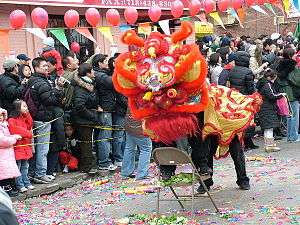
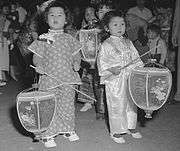
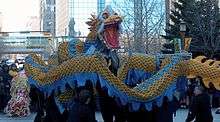
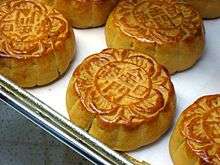
Benevolent and business associations
A major component of many Chinatowns is the family benevolent association, which provides some degree of aid to immigrants. These associations generally provide social support, religious services, death benefits (members' names in Chinese are generally enshrined on tablets and posted on walls), meals, and recreational activities for ethnic Chinese, especially for older Chinese migrants. Membership in these associations can be based on members sharing a common Chinese surname or belonging to a common clan, spoken Chinese dialect, specific village, region or country of origin, and so on. Many have their own facilities.
Some examples include San Francisco's prominent Chinese Consolidated Benevolent Association (中華總會館 Zhōnghuá Zǒng Huìguǎn), aka Chinese Six Companies, and Los Angeles' Southern California Teochew Association. The Chinese Consolidated Benevolent Association is among the largest umbrella groups of benevolent associations in the North America, which branches in several Chinatowns. Politically, the CCBA has traditionally been aligned with the Kuomintang and the Republic of China.
The London Chinatown Chinese Association is active in Chinatown, London. Chinatown, Paris has an institution in the Association des Résidents en France d'origine indochinoise and it servicing overseas Chinese immigrants in Paris who were born in the former French Indochina.
Traditionally, Chinatown-based associations have also been aligned with ethnic Chinese business interests, such as restaurant, grocery, and laundry (antiquated) associations in Chinatowns in North America. In Chicago's Chinatown, the On Leong Merchants Association was active.
Names
English
Although the term "Chinatown" was first used in Asia, it does not come from a Chinese language. Its earliest appearance seems to have been in connection with the Chinese quarter of Singapore, which by 1844 was already being called "China Town" or "Chinatown" by the British colonial government.[35][36] This may have been a word-for-word translation into English of the Malay name for that quarter, which in those days was probably "Kampong China" or possibly "Kota China" or "Kampong Tionghua/Chunghwa/Zhonghua".
The first appearance of a Chinatown outside Singapore may have been in 1852, in a book by the Rev. Hatfield, who applied the term to the Chinese part of the main settlement on the remote South Atlantic island of St. Helena.[37] The island was a regular way-station on the voyage to Europe and North America from Indian Ocean ports, including Singapore.
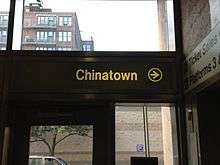
One of the earliest American usages dates to 1855, when San Francisco newspaper The Daily Alta California described a "pitched battle on the streets of [SF's] Chinatown." [38] Other Alta articles from the late 1850s make it clear that areas called "Chinatown" existed at that time in several other California cities, including Oroville and San Andres.[39][40] By 1869, "Chinatown had acquired its full modern meaning all over the U.S. and Canada. For instance, an Ohio newspaper wrote: "From San Diego to Sitka..., every town and hamlet has its 'Chinatown'."[41]
In British publications before the 1890s, "Chinatown" appeared mainly in connection with California. At first, Australian and New Zealand journalists also regarded Chinatowns as Californian phenomena. However, they began using the term to denote local Chinese communities as early as 1861 in Australia[42] and 1873 in New Zealand.[43] In most other countries, the custom of calling local Chinese communities "Chinatowns" is not older than the twentieth century.
Several alternate English names for Chinatown include China Town (generally used in British and Australian English), The Chinese District, Chinese Quarter, and China Alley (an antiquated term used primarily in several rural towns in the western United States for a Chinese community; some of these are now historical sites). In the case of Lillooet, British Columbia, Canada, China Alley was a parallel commercial street adjacent to the town's Main Street, enjoying a view over the river valley adjacent and also over the main residential part of Chinatown, which was largely of adobe construction. All traces of Chinatown and China Alley there have disappeared, despite a once large and prosperous community.
Chinese
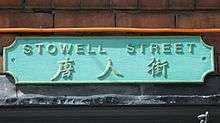
In Chinese, Chinatown is usually called 唐人街, in Cantonese Tong yan gai, in Mandarin Tángrénjiē, in Hakka Tong ngin gai, and in Toisan Hong ngin gai, literally meaning "Tang people's street(s)". The Tang Dynasty was a zenith of the Chinese civilization, after which some Chinese call themselves. Some Chinatowns are indeed just one single street, such as the relatively short Fisgard Street in Victoria, British Columbia, Canada.
A more modern Chinese name is 華埠 (Cantonese: Waa Fau, Mandarin: Huábù) meaning "Chinese City", used in the semi-official Chinese translations of some cities' documents and signs. Bù, pronounced sometimes in Mandarin as fù, usually means seaport; but in this sense, it means city or town. Likewise, Tong yan fau (唐人埠 Tángrén bù "Tang people's town") is also used in Cantonese nowadays. The literal word-for-word translation of Chinatown—Zhōngguó Chéng (中國城) is also used, but more frequently by visiting Chinese nationals rather than immigrants of Chinese descent who live in various Chinatowns.
Some Chinatowns have unique Chinese names used by the local Chinese. For example, the Chinese name for Chinatown in Singapore is Niúchēshǔi (牛车水, Hokkien POJ: Gû-chia-chúi), which literally means "ox-cart water" from the Malay 'Kreta Ayer' in reference to the water carts that used to ply the area. The Chinatown in Kuala Lumpur, Malaysia, while officially known as Petaling Street (Malay: Jalan Petaling), is referred to by Malaysian Chinese by its Cantonese name ci4 cong2 gaai1 (茨厂街, pinyin: Cíchǎng Jiē), literally "tapioca factory street", after a tapioca starch factory that once stood in the area. In Manila, the area is called Mínlúnluò Qū 岷倫洛區, literally the "district near the Rivers Mín Coherent to the River Luò". This is however a transliteration of the local term "Binondo" and an allusion to its proximity to the Pasig River.
Other languages
In Francophone regions (such as France and Quebec), Chinatown is often referred to as le quartier chinois (the Chinese Quarter; plural: les quartiers chinois). The most prominent Francophone Chinatowns are located in Paris and Montreal.
The Spanish-language term is usually barrio chino (Chinese neighborhood; plural: barrios chinos), used in Spain and Latin America. (However, barrio chino or its Catalan cognate barri xinès do not always refer to a Chinese neighborhood: these are also common terms for a disreputable district with drugs and prostitution, and often no connection to the Chinese.).
The Vietnamese term for Chinatown is Khu người Hoa (Chinese district) or phố Tàu (Chinese street). Vietnamese language is prevalent in Chinatowns of Paris, Los Angeles, Boston, Philadelphia, Toronto, and Montreal as ethnic Chinese from Vietnam have set up shop in them.
In Japanese, the term "chūkagai" (literally "Chinese Street") is the translation used for Yokohama and Nagasaki Chinatown.
In Indonesia, chinatown is known as Pecinan, a shortened term of pe-cina-an, means everything related to the Chinese people. Most of these pecinans usually located in Java.[44]
Some languages have adopted the English-language term, such as Dutch and German.
Locations
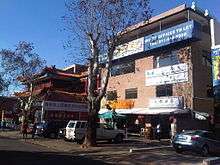
Africa
There are three noteworthy Chinatowns in Africa located in the coastal African nations of Madagascar, Mauritius, and South Africa. South Africa has the largest Chinatown and the largest Chinese population of any African country and remains a popular destination for Chinese immigrants coming to Africa. Derrick Avenue in Cyrildene, Johannesburg hosts South Africa's largest Chinatown.
Americas
In the Americas, which includes North America, Central America and South America, Chinatowns have been around since the 1800s. The most prominent ones exist in the United States and Canada in New York City, San Francisco, and Vancouver. New York City is home to the largest ethnic Chinese population outside of Asia, including several Chinatowns in and around Manhattan, Flushing, and Brooklyn. There is also a Little Fuzhou developing in Manhattan and in a nearby area of Brooklyn. San Francisco, a Pacific port city, has the oldest and longest continuous running Chinatown in the Western Hemisphere.[45][46][47] In Canada, Vancouver's Chinatown is the country's largest.[48]
The oldest Chinatown in the Americas is in Mexico City and dates back to at least the early 17th century.[49] Since the 1970s, new arrivals have typically hailed from Hong Kong, Macau, and Taiwan. Latin American Chinatowns may include the descendants of original migrants – often of mixed Chinese and Latin parentage – and more recent immigrants from East Asia. Most Asian Latin Americans are of Cantonese and Hakka origin. Estimates widely vary on the number of Chinese descendants in Latin America. Notable Chinatowns also exist in Lima, Peru.


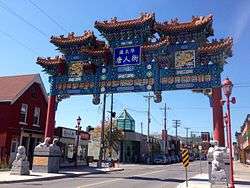
Asia
Chinatowns in Asia are widespread with a large concentration of overseas Chinese in East Asia and Southeast Asia and ethnic Chinese whose ancestors came from southern China – particularly the provinces of Guangdong, Fujian, and Hainan – and settled in countries such as Brunei, Cambodia, Indonesia, Laos, Malaysia, Myanmar, Singapore, the Philippines, Thailand, and Vietnam centuries ago—starting as early as the Tang Dynasty, but mostly notably in the 17th through the 19th centuries (during the reign of the Qing Dynasty), and well into the 20th century. Today the Chinese diaspora in Asia is largely concentrated in Southeast Asia however the legacy of the once widespread overseas Chinese communities in Asia is evident in the many Chinatowns that are found across East Asia, South Asia, and Southeast Asia.
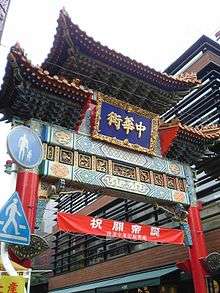
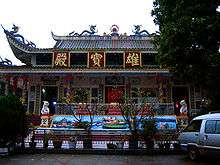


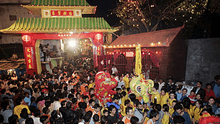
Australia and Oceania
The Chinatown of Melbourne lies within the Melbourne Central Business District and centers on the eastern end of Little Bourke Street. It extends between the corners of Swanston and Exhibition Streets. Melbourne's Chinatown originated during the Victorian gold rush in 1851, and is notable as the oldest Chinatown in Australia. It has also been claimed to be the longest continuously running Chinese community outside of Asia, but only because the 1906 San Francisco earthquake all but destroyed the Chinatown in San Francisco in California.[45][46][47]
Sydney's main Chinatown centers on Sussex Street in the Sydney downtown. It stretches from Central Station in the east to Darling Harbour in the west, and is Australia's largest Chinatown.
The Chinatown of Adelaide was originally built in the 1960s and was renovated in the 1980s. It is located near Adelaide Central Market and the Adelaide Bus Station.
Chinatown Gold Coast is a precinct in the Central Business District of Southport, Queensland, that runs through Davenport Street and Young Street. The precinct extends between Nerang Street in the north and Garden Street/Scarborough Street east-west. Redevelopment of the precinct was established in 2013 and completed in 2015 in time for Chinese New Year celebrations.
There are additional Chinatowns in Brisbane, Perth and Broome in Australia.

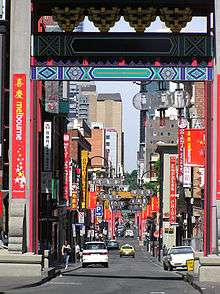
Europe
Several urban Chinatowns exist in major European capital cities. There is Chinatown, London, England as well as major Chinatowns in Birmingham, Liverpool, Newcastle and Manchester. Berlin, Germany has two established Chinatowns, with the Dong Xuan Center around Herzbergstrasse of Lichtenberg in the East, and the area around Kantstrasse of Charlottenburg in the West. Antwerp, Belgium has also seen an upstart Chinese community, that has been recognized by the local authorities since 2011.[50] The city council of Cardiff has plans to recognize the Chinese Diaspora in the city.[51]
The Chinatown in Paris, located in the 13th arrondissement, is the largest in Europe, where many Vietnamese – specifically ethnic Chinese refugees from Vietnam – have settled and in Belleville in the northeast of Paris as well as in Lyon. In Italy, there is a Chinatown in Milan between Via Luigi Canonica and Via Paolo Sarpi and others in Rome and Prato. In the Netherlands, Chinatowns exist in Amsterdam, Rotterdam and the Hague.
In the United Kingdom, several exist in Birmingham, Liverpool, London, Manchester and Newcastle Upon Tyne. The Chinatown in Liverpool is the oldest Chinese community in Europe.[52] The Chinatown in London was established in the Limehouse district in the late 19th century. The Chinatown in Manchester is located in central Manchester.
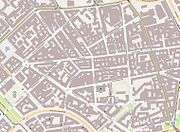
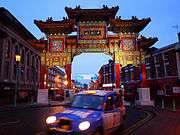
.jpg)
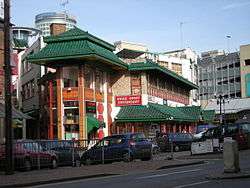
In popular culture
Chinatowns have been referenced in various films including The Joy Luck Club, Big Trouble in Little China, and Chinatown. Also, many films in which Jackie Chan appears reference locations in Chinatown, particularly the Rush Hour series with Chris Tucker.
Chinatowns have also been mentioned in the song "Kung Fu Fighting" by Carl Douglas whose song lyrics says "... There was funky China men from funky Chinatown...."[53]
The martial arts actor Bruce Lee is well known as a person who was born in the Chinatown of San Francisco.[54] Other notable Chinese Americans such as politician Gary Locke and NBA player Jeremy Lin grew up in suburbs with lesser connections to traditional Chinatowns. Neighborhood activists and politicians have increased in prominence in some cities, and some are starting to attract support from non-Chinese voters.
See also
| Wikimedia Commons has media related to: |
- Africans in Guangzhou, the largest people of the African diaspora living in China
- Chinatown bus lines
- Europe Street, a street in China dedicated to European culture
- Jack Manion San Francisco's Chinatown squad
- List of U.S. cities with significant Chinese-American populations
- Koreatown
- Japantown
- Little Saigon
- Little Manila
- Little India
- List of named ethnic enclaves in North American cities
- Chinatowns in Asia
- Chinatowns in Europe
- Chinatowns in the United States
References
Citations
- ↑ "Connecticut's Unexpected Chinatowns". Archived from the original on 2016-10-31.
- ↑ "Fortune, friction and decline as casino 'Chinatown' matures".
- ↑ "Definition of Chinatown". Archived from the original on 2014-02-28.
- ↑ "Where You Live Chinatown". Archived from the original on 2014-03-01.
- ↑ Little Saigons: Staying Vietnamese in America.
- ↑ "Archived copy". Archived from the original on 2016-03-04. Retrieved 2016-02-21.
- ↑ "Ethnoburb: The New Ethnic Community in Urban America". Archived from the original on 2014-03-03.
- ↑ "Asians in Thriving Enclaves Keep Distance From Whites". bloomberg.com. Archived from the original on 22 January 2015. Retrieved 2 May 2018.
- ↑ "Chinatown Revisited". Archived from the original on 2017-07-06.
- ↑ "From Chinatown to Ghost Town". Nhpr.org. 2011-11-14. Archived from the original on 2013-11-01. Retrieved 2013-05-26.
- ↑ Raitisoja, Geni "Chinatown Manila: Oldest in the world" Archived 2011-04-02 at the Wayback Machine., Tradio86.com, July 8, 2006, accessed March 19, 2011.
- ↑ Takekoshi, Yosaburo (2004). economic aspects of the history of the civilization of Japan, Vol. 2. London: Routledge. p. 124.
- ↑ Li, Qingxin (2006). Maritime Silk Road. China International Press. p. 157.
- ↑ Abeyesekere, Susan (1987). Jakarta: A History. Oxford University Press. All rights reserved. p. 6.
|access-date=requires|url=(help) - ↑ "Calcutta's Chinatown facing extinction over new rule - Taipei Times". www.taipeitimes.com. Archived from the original on 13 May 2011. Retrieved 2 May 2018.
- ↑ "The History of Chinatown Bangkok". Yaowarat Heritage Centre. Archived from the original on 20 September 2011. Retrieved 2 October 2011.
- 1 2 "History of Liverpool Chinatown". The Liverpool Chinatown Business Association. Archived from the original on 24 January 2010. Retrieved 31 January 2011.
- ↑ Documentary film about the early history of San Francisco's Chinatown Archived 2014-01-06 at the Wayback Machine., KPIX-TV, 1963.
- ↑ Lee Foster (1 October 2001). Northern California History Weekends. Globe Pequot. p. 13. ISBN 978-0-7627-1076-8. Retrieved 26 December 2011.
- ↑ Okihiro, Gary Y. (2015). American History Unbound: Asians and Pacific Islanders. Berkeley: University of California Press. p. 201. ISBN 978-0-520-27435-8. Archived from the original on 2018-05-02.
- ↑ Sales, Rosemary; d'Angelo, Alessio; Liang, Xiujing; Montagna, Nicola. "London's Chinatown" in Donald, Stephanie; Kohman, Eleonore; Kevin, Catherine. (eds) (2009). Branding Cities: Cosmopolitanism, Parochialism, and Social Change. Routledge. pp. 45–58.
- ↑ "Albany's new 'Chinatown' features teahouse; other businesses sought". Bizjournals.com. 2010-01-11. Archived from the original on 2013-11-11. Retrieved 2013-05-26.
- ↑ "Developers Plan Chinatown Outside Raleigh". Wwaytv3.com. Archived from the original on 2013-05-30. Retrieved 2013-05-26.
- ↑ "The Best Chinese Probably Isn't In Chinatown". Huffingtonpost.com. 2012-12-04. Archived from the original on 2013-11-11. Retrieved 2014-02-28.
- ↑ Bonnie Tsui. American Chinatown: A People's History of Five Neighborhoods.
- ↑ "Chinatown Area Plan (San Francisco Chinatown)". Archived from the original on 2014-05-19.
- ↑ "Chinatown Philadelphia PA". Archived from the original on 2014-07-02.
- ↑ "China City Of America: New Disney-Like Chinese-Themed Development Plans To Bring $6 Billion To Catskills In New York State". Archived from the original on 2014-03-07.
- ↑ "American FactFinder". Archived from the original on 2011-02-12.
- ↑ "The End of Chinatown". Theatlantic.com. Archived from the original on 2013-07-10. Retrieved 2013-05-26.
- ↑ "Yearbook of Immigration Statistics: 2011 Supplemental Table 2". U.S. Department of Homeland Security. Archived from the original on 2012-08-08. Retrieved 2013-02-12.
- ↑ "Yearbook of Immigration Statistics: 2010 Supplemental Table 2". U.S. Department of Homeland Security. Archived from the original on 2012-07-12. Retrieved 2013-02-12.
- ↑ John Marzulli (May 9, 2011). "Malaysian man smuggled illegal Chinese immigrants into Brooklyn using Queen Mary 2: authorities". New York: © Copyright 2012 NY Daily News.com. Archived from the original on June 23, 2012. Retrieved 2013-02-12.
- ↑ "Chinese New Year 2012 in Flushing". QueensBuzz.com. January 25, 2012. Archived from the original on May 26, 2013. Retrieved 2013-06-10.
- ↑ "Trade and Commerce in Singapore". Simmond's Colonial Magazine and Foreign Miscellany: 335. Jan–Apr 1844. Archived from the original on 2011-12-22. Retrieved 2011-12-20.
- ↑ Sydney Morning Herald. 1844-07-23. p. 2. Missing or empty
|title=(help) - ↑ Hatfield, Edwin F. (1852). St. Helena and the Cape of Good Hope. p. 197.
- ↑ Alta California. 1855-12-12. p. 1. Missing or empty
|title=(help) - ↑ Alta California. 1857-12-12. p. 1. Missing or empty
|title=(help) - ↑ Alta California. 1858-06-04. p. 2. Missing or empty
|title=(help) - ↑ Defiance Democrat. 1869-06-12. p. 5. Missing or empty
|title=(help) - ↑ Ballarat Star. 1861-02-16. p. 2. Missing or empty
|title=(help) - ↑ Tuapeka Times. 1873-02-06. p. 4. Missing or empty
|title=(help) - ↑ Bunnell, Tim; Parthasarathy, D.; Thompson, Eric C. (2012-12-11). Cleavage, Connection and Conflict in Rural, Urban and Contemporary Asia. Springer Science & Business Media. ISBN 9789400754829. Archived from the original on 2017-10-23.
- 1 2 Bacon, Daniel: Walking the Barbary Coast Trail 2nd ed., page 50, Quicksilver Press, 1997
- 1 2 Richards, Rand: Historic San Francisco, 2nd Ed., page 198, Heritage House Publishers, 2007
- 1 2 Morris, Charles: San Francisco Calamity by Earthquake and Fire, pgs. 151-152, University of Illinois Press, 2002
- ↑ "Chinatown Vancouver Online". Vancouverchinatown.ca. Archived from the original on 2011-09-03. Retrieved 2011-09-11.
- ↑ Mann, Charles C. (2012). 1493: Uncovering the New World Columbus Created. Random House Digital, Inc. p. 416. ISBN 978-0-307-27824-1. Retrieved 12 October 2012.
- ↑ "China Town Antwerpen". Chinatown-antwerpen.be. Archived from the original on 2011-09-20. Retrieved 2011-09-11.
- ↑ "What happened to cardiff china town? - Discussion Board". Britishchineseonline.com. 2005-10-05. Retrieved 2011-09-11.
- ↑ "Liverpool and it's Chinese Children". Halfandhalf.org.uk. Archived from the original on 2011-10-02. Retrieved 2011-09-11.
- ↑ Carl Douglas. "Kung Fu Fighting". Missing or empty
|url=(help) - ↑ Ohanesian, Liz (12 February 2015). "Bruce Lee's Huge Bronze Statue Turns Into a Mecca in L.A.'s Chinatown (VIDEO)". laweekly.com. Archived from the original on 4 January 2018. Retrieved 2 May 2018.
Sources
- Chew, James R. "Boyhood Days in Winnemucca, 1901–1910." Nevada Historical Society Quarterly 1998 41(3): 206–209. ISSN 0047-9462 Oral history (1981) describes the Chinatown of Winnemucca, Nevada, during 1901–10. Though many Chinese left Winnemucca after the Central Pacific Railroad was completed in 1869, around four hundred Chinese had formed a community in the town by the 1890s. Among the prominent buildings was the Joss House, a place of worship and celebration that was visited by Chinese president Sun Yat-Sen in 1911. Beyond describing the physical layout of the Chinatown, the author recalls some of the commercial and gambling activities in the community.
- Ki Longfellow, China Blues, Eio Books 2012, ISBN 0975925571, San Francisco's Chinatown during the 1906 earthquake and in the early 1920s. ()
- "Chinatown: Conflicting Images, Contested Terrain", K. Scott Wong, Melus (Vol. 20, Issue 1), 1995. Scholarly work discussing the negative perceptions and imagery of old Chinatowns.
- Pan, Lynn. Sons of the Yellow Emperor: A History of the Chinese Diaspora (1994). Book with detailed histories of Chinese diaspora communities (Chinatowns) from San Francisco, Honolulu, Bangkok, Manila, Johannesburg, Sydney, London, Lima, etc.
- Williams, Daniel. "Chinatown Is a Hard Sell in Italy", The Washington Post Foreign Service, March 1, 2004; Page A11.
